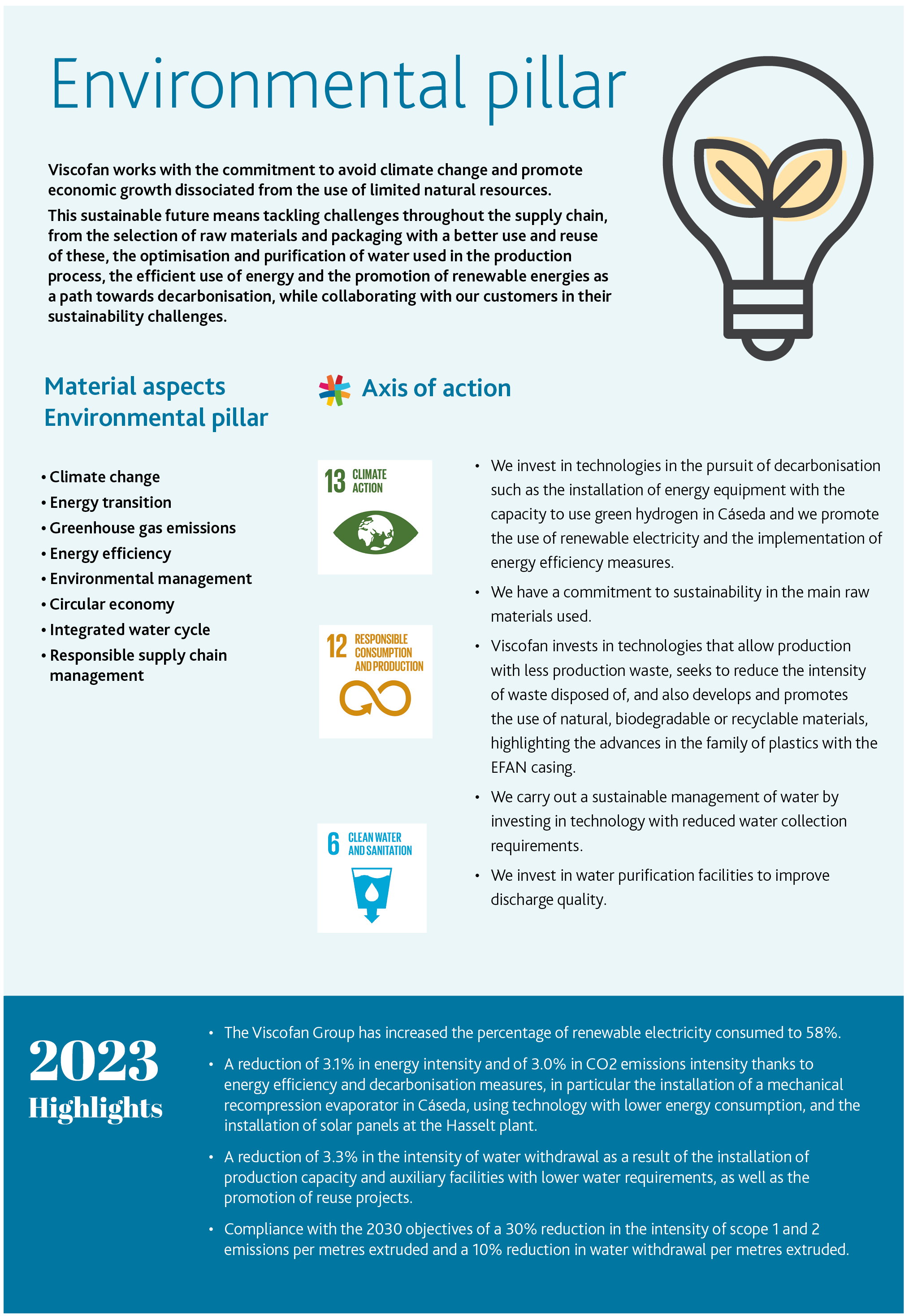

Environmental sustainability encompasses relevant aspects identified in the materiality analysis and as such is included in the Group's governance and operational management processes. It is an essential part of our risk mitigation in our Sustainability Action Plan.
As the chief executive officer of Viscofan's activities, the CEO is the first executive responsible for environmental sustainability and leads the Executive Sustainability Committee
The Board of Directors is ultimately responsible for environmental sustainability management. By extension, the Board's Appointments, Remuneration and Sustainability Committee, among its functions, promotes and supervises compliance with sustainability policies in environmental matters, ensuring that they are improved and that they take into account the legitimate interests of stakeholders.
The Audit Committee is also responsible for reviewing the effectiveness of the Group's systems of internal control and management of financial and non-financial risks, including environmental risks, and for monitoring and evaluating the process of preparing and presenting the Group's non-financial information.
As the chief executive officer of Viscofan's activities, the CEO is the first executive responsible for environmental sustainability and leads the Executive Sustainability Committee in charge of coordinating and supervising the objectives, initiatives and long-term work plans established by Viscofan in the field of sustainability, and in particular environmental sustainability.
The management of environmental aspects at Group level is the responsibility of the Corporate Operational Sustainability Department, reporting to the Operations Department, which is in charge of coordinating and supervising this matter in all the Group's production plants.
Climate change management is regulated in the Climate Change Policy, and demonstrates the Group's commitment to the control of atmospheric emissions, energy efficiency, as well as a business strategy related to the development of alternative energy sources.
In addition, the Group has an Environmental Policy which sets out that the Group's procedures must be carried out with respect for the environment, which means incorporating sustainable development criteria in all areas of activity, guaranteeing the efficient management of natural resources, and minimising the undesirable effects of the activity.
Remuneration is an important component of corporate governance used to encourage and guide the implementation of commitments and actions within Viscofan.
In this context, the remuneration systems for members of the Board of Directors and employees are aligned with the Beyond25 strategy, and in particular with sustainability, given its importance as one of the four strategic pillars. Consequently, sustainability indicators are integrated into our short and long-term incentives.
The Group has a Sustainability Action Plan for the period 2022-2025 approved by the Board of Directors, in line with the Beyond25 strategic plan.
This plan, among other aspects, identifies risks and opportunities and establishes the Group's metrics, objectives, and initiatives in relation to them.
Environmental sustainability brings with it a number of risks and opportunities for the casing industry that need to be identified and managed in order to minimise negative impacts on our environment, while taking advantage of all the associated positive aspects.
for the period 2022-2025 approved by the Board of Directors, in line with the Beyond25 strategic plan.
In particular, climate change is a risk identified in the Global Risk Map, since its implications may hinder the achievement of long-term objectives and the creation of value for stakeholders.
Viscofan's climate risk and opportunity management model is based on the COSO ERM and Task Force on Climate-Related Financial Disclosures (TCFD) recommendations, as well as the company's Risk Control and Management Policy, which also considers impacts and dependencies.
Viscofan has identified a total of 15 climate risks and 8 opportunities, based on TCFD's own recommendations, reference institutions (IEA and IPCC), and the analysis of comparable companies.
For this analysis, three global warming scenarios have been established (1.5ºC, 2.4ºC, and 4.0ºC), referring to the risks and opportunities at different materialisation time horizons:
• Current or already materialised, or short-term future: materialisation in a period of less than 5 years
• Near or medium-term future: materialisation in the next 5 to 15 years, applicable for all scenarios that offer projections to 2030.
• Long-term future: materialisation in a period of more than 15 years, applicable for all scenarios that offer projections to 2040 or later.

Subsequently, to determine which risks and opportunities could have a material financial impact on the organisation, the Executive Sustainability Committee has evaluated their potential impact, probability and the mitigating actions put in place, and a scenario analysis has been carried out. This shows the main effects of the most significant risks on Viscofan's business, and on its strategy and financial planning, to be:
• Shortage of collagen skins
• Shortage of water
• Regulatory changes
• Transitional to low-emission technologies
The most significant opportunities are:
• Access to new markets
• Efficiency of production processes
• Promotion of renewable and sustainable energies
by actively deciding on how to respond, while also seeking to take advantage of opportunities by incorporating them into our strategy.
Viscofan's objective is to avoid or mitigate risks by actively deciding on how to respond, while also seeking to take advantage of opportunities by incorporating them into our strategy.
Where necessary, we take appropriate countermeasures or, to the extent possible and economically acceptable, transfer them to third parties (such as insurers). Opportunities and risks are continuously monitored using indicators, so that, for example, changes in the economic or legal environment can be identified at an early stage and, if necessary, appropriate response measures implemented.
Below is the long-term annual assessment of climate-related risk impacts and opportunities, and the mitigation response:
Potential impact: Viscofan's production process is energy intensive, so legislative proposals related to this resource and aimed at mitigating climate change may have a particular impact on the business. This is the case of the increase in the price of CO2, carbon taxes or emission restrictions, which may affect the industrial and other energy-intensive sectors.
In this respect, the increased price of greenhouse gas emissions and the extension of its mechanism worldwide has an impact on the Group's operating costs. Based on the analysis of the scenarios, this risk could entail an additional cost in the long term in the range of €20Mn to €70Mn.
Impact in 2023: The CO2 emission rights expenditure is €22.6 million.
Response: Viscofan is implementing actions within its decarbonisation plan:
• Investment in energy equipment with the capacity to use green hydrogen as a renewable energy source. Specifically, the Cáseda plant has energy equipment to use this energy vector, and which has replaced others whose useful life had come to an end. In 2022 and 2023, Viscofan also carried out tests using green hydrogen in a co-generation engine, testing the feasibility while producing casings.
• Electric boilers are being installed at the Cáseda plant and a study has been done and a project approved to carry out a PPA (Purchase Power Agreement) for solar panels at the Cáseda plant for self-sufficiency in renewable electricity.
• Work has begun on the installation of a biomass boiler at the Cáseda plant.
Potential impact: The increase in the planet's average temperatures can increase the risk of water stress, causing a lack of supply at production plants. According to the World Resources Institute (WRI), Viscofan is present in some countries where water stress is expected to increase. Drought and water shortage events could lead to restrictions on water use in these areas, directly affecting the company's production chain.
Supply shortages at plants could cause production stoppages, leading to a shortfalls to meet demands several days a year. On this basis, according to the climate scenarios analysed, this risk could have a long-term impact of an annual loss of equivalent sales of between €17 Mn and €70 Mn.
Impact in 2023: The Viscofan Group plants have had no water supply problems during the year.
Response: Viscofan is implementing measures to mitigate this risk:
• Within the Sustainability Action Plan, Viscofan is analysing possible scenarios and measures to be implemented faced with this possible long-term risk.
• Likewise, the 2030 commitments include reducing the intensity of water withsrawal. To comply with this, Viscofan is developing and investing in technologies that require less water, promoting and studying the viability of reusing water in the production process and investing in the best available water treatment and discharge technologies.
Potential impact: High ambition on the part of governments to achieve carbon neutrality may accelerate the replacement of equipment that is not fully amortised and cause the company to incur unforeseen extra costs.
Impairment of existing energy assets and investment in equipment that uses renewable energy sources or that generates fewer carbon emissions. If the speed of this transition is faster than the amortisation period of the equipment or requires non-mature energy technologies to be adopted, it can lead to significant associated costs and investments, as well as loss of overall product competitiveness.
Based on Krishnan et al 2021 estimates, the Net Zero 2050 scenario would require spending on physical assets equivalent to around 7.5% of GDP during the period 2021 to 2050. Based on this assumption, this risk could entail a long-term investment in assets of around €60 million, calculated according to a linear proportion between production at base prices and national GDP and using the regional average to calculate the contribution of factories to GDP.
Impact in 2023: For now, based on the analysis carried out following the Net Zero Emissions (NZE) scenario of the IAE, the transition commitments to low-emission technology of the different governments of the countries in which Viscofan is present have a time horizon longer than the useful life of the energy equipment.
Response: Viscofan, as part of its decarbonisation objective, is seeking to invest in energy equipment that uses renewable energies to the extent that the existing ones have reached the end of their useful life, as well as the diversification of energy sources to achieve greater self-consumption.
Potential impact: The physical consequences of global warming or climate change regulation itself may lead to higher prices for raw materials, affecting the company's procurement, transport and distribution worldwide. Increases in the price of raw materials may be caused by their reduced access or availability, or by their carbon footprint.
The cumulative effects of climate change impacts on global forage productivity could translate into falls of 7 to 10% in livestock numbers by 2050 if warming of 2.2°C materialises. At temperatures above 30°C, animals eat 3-5% less per additional degree of temperature, which reduces their productivity and fertility. These climate change consequences may lead to a lower availability of collagen hides and so to increases in its price.
Using the IPCC RCP2.6, IPCC RCP4.5, and IPCC RCP8.5 scenarios, and in the hypothetical case that these effects occur in the regions where Viscofan is present, a possible lower revenue impact has been estimated in the range of €50 Mn to €100 Mn due to lack of availability of collagen skin.
Impact in 2023: During the year, there have been no situations of lack of availability of collagen hides.
Response: Viscofan has mitigation tools to compensate for the increase in raw material prices:
• Passing on cost inflation through higher selling prices to customers.
• Specific R&D projects and production trials encouraging diversification of sources of supply and suppliers.
• Investment and development of more efficient and less wasteful production processes.
However, from the analysis performed, no impairment was identified on the current assets and no significant investments were envisaged to comply with the commitments established in our 2022-2025 Sustainability Action Plan.
Viscofan's integral risk management system assesses and monitors the risks and their evolution, taking the necessary management measures which, aside from mitigating the risk, may generate opportunities.
Access to new markets: Viscofan has extensive experience in the sector and based on knowledge of the treatment of raw materials and processes, and continuous dialogue with the food sector, it can identify business opportunities in benefiting from product circularity, water savings and productive efficiencies, as well as the use of casings on vegetable sausages or other types of ingredients that contribute to a more sustainable diet.
Efficiency of production processes: the reduction in the intensity of use of resources such as energy or water, as well as a reduction in the generation of waste, could lead to savings for Viscofan and represent a competitive improvement compared to other market players that do not adopt this type of strategy. To this end, it is necessary to optimise and improve manufacturing processes, establishing circularity and efficiency measures in terms of water, waste, and energy.
Promotion of renewable and sustainable energies: Viscofan is working to promote the decarbonisation of its processes using green hydrogen as an energy vector. If this technology were available on a competitive and continuous basis, it would save on CO2emissions and the associated cost of emission rights.
Viscofan's commitment to environmental improvement and the fight against climate change is also revealed in its human, operating and financial dimension.
The breakdown of the Group's plants with the ISO 14.001 certificate at 31 December 2023 is as follows:
| Country | Plant | ISO 14.001 |
| Spain | Cáseda | Yes |
| Urdiain | Yes | |
| Germany | Weinheim | Yes |
| Alfhausen | Yes | |
| Serbia | Novi Sad | Yes |
| Czech Republic | České Budějovice | Yes |
| Belgium | Hasselt | Yes |
| US | Danville | No |
| Montgomery | Yes | |
| New Jersey | Yes | |
| Mexico | Zacapu | Yes |
| San Luis Potosi | Yes | |
| Brazil | Itu | Yes |
| Matarazzo | Yes | |
| Uruguay | Pando | Yes |
| China | Suzhou (2 plants) | Yes |
| Australia | Sydney | Yes |
We are working to attain this environmental management certification at all our production plants. At 2023 year-end, 89% of the plants have this certificate. During the year, this certificate was obtained for the New Jersey (USA) plant.
The breakdown of the Group's plants with the ISO 14.001 certificate.
ISO 50.001 energy efficiency certificates
The Cáseda and Urdiain (Spain), Weinheim (Germany) and České Budějovice (Czech Republic) plants have an ISO 50.001 standard certificate, enabling the plants to improve their efficiency, energy costs and green greenhouse emissions.
As part of its commitment to improve energy management, the Group plans to obtain this certificate for other plants.
Other certificates
Viscofan's New Business division obtained the ISCC PLUS certification from the plastic extrusion and plastic converting centres in Brazil, Mexico, Belgium and Germany. Furthermore, the extrusion and converting centre in the Czech Republic obtained the ISCC PLUS recertification. This certification system ensures the sustainability of raw materials and products for several markets.
The plant in the Czech Republic has received the PRS Green Label certificate from PRS Pooling for its implementation of the recycling system for non-standard pallets of raw materials (PRS). A certificate that represents recognition for contributing to sustainability in the industrial sector.
Part of Viscofan's industrial asset base relates to environmental management, seeking the best available technology in the management of water, energy, and waste, among others. Hence, at the end of December 2023, the gross value of this type of asset was €94.3 million (€78.0 million at 31 December 2022).
Viscofan continues its quest to improve environmental management and with this objective in mind, in 2023, it invested €16.3 million in this area (€12.6 million in 2022). The investment projects in energy equipment that contribute to the reduction of CO2 such as electric boilers, energy recovery or solar panels; and also installations for processing waste from the production process.
environmental management and with this objective in mind, in 2023, it invested €16.3 million in this area.
Being more sustainable and reducing our impact on the environment is a commitment for all of us. In addition to allocating financial resources, measures are also promoted to improve the Group's values and commitments regarding environmental management among employees, with training courses standing as an essential element of the management approach.
The training carried out for people involved in the reporting process and the non-financial information control system implemented in the Group in 2023, as well as the training carried out at the local level for investigation of environmental events, are worthy of note.
In 2023, the Viscofan Group had not received any significant environmental penalties.

Uso de cookies
Utilizamos cookies propias y de terceros para analizar nuestros servicios y mostrarle publicidad relacionada con sus preferencias. Pulsando “Configurar” puede seleccionar las cookies que se instalarán en su dispositivo. Pulsando “Aceptar” consiente su instalación y el uso de todas las cookies que utilizamos. Puede obtener más información aquí.
ACEPTAR COOKIES Configuración de cookies